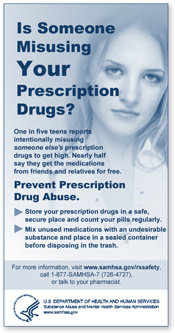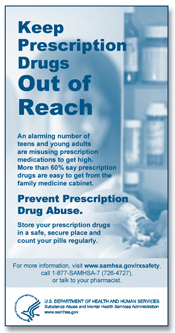Campaign: Proper Disposal of
Prescription Drugs
Educating people about safe disposal of prescription medicines, especially painkillers and sleep aids, is the focus of a new SAMHSA pilot program.
Prescription drug misuse is a growing problem. To help, SAMHSA is providing point-of-sale information sheets at more than 6,000 pharmacy counters across the Nation.
The pilot program is intended to combat the increasing abuse of prescription drugs-particularly among teens and young adults.
These information sheets highlight the need for preventing abuse of these medications and provide practical advice on how to store medication properly and dispose of unused amounts.
"This program is so important because most prescription drug abusers get these drugs through a friend or relative," said SAMHSA Administrator Terry L. Cline, Ph.D.
In fact, 55.7 percent of people age 12 and older who used pain relievers nonmedically in the past year reported that they obtained the drugs from a friend or relative for free during the most recent time of use, according to recently released results from SAMHSA's 2006 National Survey on Drug Use and Health.
Although levels of illicit drug abuse among youth had declined in many areas over the past few years, the survey found that prescription drug abuse has grown significantly. The level of nonmedical use of prescription drugs among young adults increased from 5.4 percent in 2002 to 6.4 percent in 2006, due largely to an increase in the nonmedical use of pain relievers.
Educating Consumers
Because a high percentage of teens and young adults report that they have access to prescription drugs in family medicine cabinets, SAMHSA is focusing on teaching people how to reduce and eliminate this access.
To help educate parents and other members of the public, SAMHSA is disseminating point-of-sale information to consumers who purchase highly abused prescription drugs such as hydrocodone, select sleep aids, and oxycodone (OxyContin®).
Using new technology that automatically selects the appropriate information sheet for the medication being purchased, consumers will receive one of three information sheets on abuse prevention when they fill prescriptions for one of these drugs at pharmacies participating in the program.
Additional information on this program can be found on the SAMHSA Web site at www.samhsa.gov/rxsafety. For additional information, studies, data, and reports on prescription drug abuse, including data from the Agency's Drug Abuse Warning Network, visit SAMHSA's Web site at www.oas.samhsa.gov/prescription.htm. 
« Previous Article
Next Article »
Back to Top |



